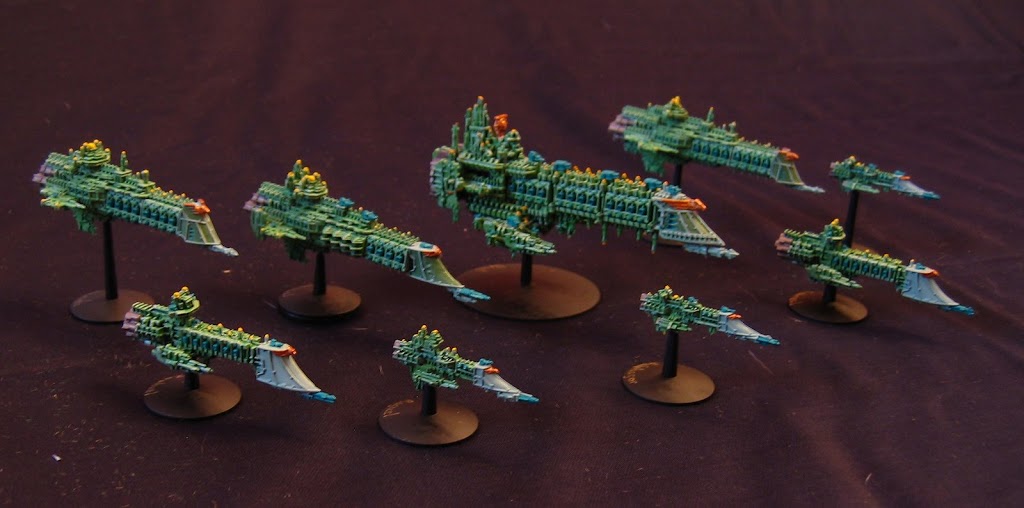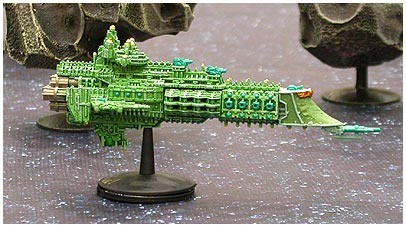BFG: Game Sequence 101

A guest post by Fracas
Hello all. Previously I have posted about the genre and fluff appeals of BFG. Today I want to spend some time on the game mechanics. Many of us believe BFG have among the best of GW’s rulesets. While certainly not perfect, I do believe that it is tight. This post will focus primarily on the turn sequence.
Pre Game: The pre-game activities are primarily about determining leadership values of your ships. Though you can purchase one or more leaders with preset leadership value, this is in large a random process. Since you have little control over the value you roll, the most important aspect of leadership is actually whether to squadron your cruisers. Escorts have to be in squadron and typically most of us will not be fielding more than one or two battleship so there is not much to decide there. Regarding cruisers, there are four types based on their primary weapons: attack crafts/torpedoes ships, batteries ships, lance ships, and mixed armament ships. Which ship category a ship is in is determined by its armament and more importantly how you intend to use it as most ships have a combination of armaments. The advantage of placing cruisers in a squadron is that the squadron uses the highest leadership value in the squadron.
Firstly, since carriers (attack craft ships and to a lesser extent torpedo ships) has to reload their ordnance (attack crafts and or torpedoes) being able to use a higher leadership really matters. Not being able to reload neutralizes the carriers ability to function as carriers. In addition, one larger wave of ordnance attack is superior to smaller waves of ordnance attack. The main downside to squadroning is that the ships have to stick together.
Secondly, batteries based ship in squadron can fire together simultaneously. Since batteries attack are better simultaneous rather than in sequence, much like carriers. However, since each cruisers can still fire without needing to reload, it is not as important for them to be in squadrons. Most battery based cruisers are reasonably effective on its own.
Thirdly, most mixed armament ships have a combination of batteries and lances. Again, weapon batteries are better combined but mixed armament ships don’t carry that much batteries for there to be much degrading of effectiveness and their lances are likely able to maintain their effectiveness so squadroning them is a plus or minus affair. In general, lances don’t need to be squadroned. Oh, one more thing, if you regularly play 40k or FB more than BFG, remind yourself that BFG is played in centimeters and not inches.
Turn Sequence: Each turn consists of 2 parts, yours and your opponent. Each part consists of, in sequence, movement, shooting, ordnance, and end phase. I just have a few comments for each phase.
The Movement Phase: A couple of items worth considering here. Firstly, decide what special orders your ships will go on. Then roll for them in sequence, with highest leadership tests first. Once a special order test is failed, no other special orders can be rolled for. Secondly, all ships have to move a minimum of 1/2 their movement allowances. The only way not to move is to use special order “Burn Retros” with a leadership test. This means that everything will change and you will need to anticipate where you will be with respect in your turn as well as in your opponent’s turn. While this isn’t too different from most table top wargames like 40k and FB, most people field both a static and a mobile force in these other games. Thirdly, cruisers and battleships (with exceptions) must move a minimal distance before they can turn, 15 cm for battleships and 10 cm for cruisers. Finally, since ships do not block line of sight when shooting weapons but will block line of sight with torpedoes, I tend to move my torpedo ships first to set them up to have an unobstructed line of fire, then move my other ships to stay out of my torpedo ship arc of fire.
The shooting Phase: Each ship or squadron fires all its weapons then the next ship or squadron fires. Always fire your weapon batteries first because the presence of blasts will degrade the effectiveness of subsequent weapon batteries attacks. As a result, fire with the largest strength batteries first before weaker ones, which also suggest then that your batteries ships should fire first. Lances, which are not affected by blasts, can fire at any time. It should go without saying that concentrated fire focussed on a few targets is better than spreading your attacks among many. Once a ship loses 50% of its starting hits, it is considered crippled and its weapon goes down to half strength. Thus if it is your ship being attacked and you estimate reasonable likelihood of being crippled, you should go on special order “Brace for Impact” to get a 4+ save against each hits (after shields).
The Ordnance Phase: Four items of note. Firstly, both players get to move whatever ordnance is on the table; you get to go first in your turn and only you get to launch. Thus though leaving ordnance on the table makes them susceptible to being taken out, this isn’t necessarily a bad thing. To take out your ordnance your foe will have to shoot at them. Not only are ordnance harder to hit than your ships, if he is shooting at ordnance, he certainly won’t be shooting at your ships. Alternatively he would have to use his own ordnance to take out yours and again, since you can reload ordnance during the game but cannot “reload/reinforce” your fleet with more ships, losing ordnance is much more effective than losing ships.
One item of caution though, while one fighter can take out another attack craft, one fighter can take out a whole wave of torpedoes, thus I usually hold my torpedoes until within striking range. Secondly, turrets defenses against ordnance attacks gets to defend against each wave of ordnance attacks but for the phase must choose to defend against torpedoes or attack crafts. This means that a combined bombers and torpedoes attack has synergy. This also means one larger wave of this is better than multiple smaller waves.
Thirdly, hit and run attacks are conducted. Hit and run attacks are most effective against escorts as success results in the escort being removed from the game. A successful hit and run against capital ship is unlikely to inflict structural hits and while critical damage can be annoying and functionally degrade the effectiveness of the capital ship, this functional damage from critical hits can usually be repaired. Finally, worthy of note is that Corsair Eldar and Craftworld Eldar can move in their ordnance phase after all ordnance have moved. This allows them to hit and run.
The End Phase: In this phase you try to repair functional critical hits and conduct teleport attacks and boarding actions. You will also have to remove D6 blast markers from the tabletop. If possible, leave blast markers in front of enemy battleships if possible. Most battleship are slow and ponderous and will not be able to turn without special order Come to New Heading or Burn Retros. As we all know, part of tabletop tactics involve maximizing your mobility and minimizing your opponent’s mobility. Thus remove blast markers from in front of your own battleships if you can.
For future posts I intend to go through each fleet lists the best I can. Probably Necron, followed by Corsair Eldar, then Space Marines.
~Bigred here. Fracas will be back from time to time to take us through the paces of BFG and the strengths and weaknesses of the different fleets. He also runs Warmancer, one of the best BFG blogs out there, so by all means you interested Naval Cadets should check it out. Comments and questions are welcome, and by all means lets hear your ideas for future BFG articles.





